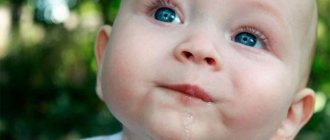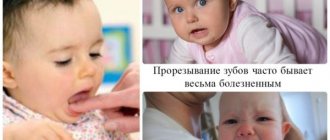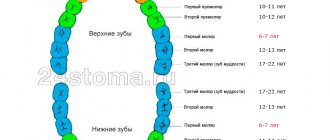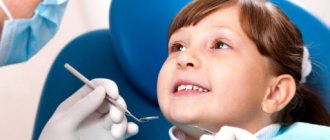Changing children's baby teeth to permanent ones is always an exciting time for parents. This process is quite lengthy and often painful for the child, because it can be accompanied by various inflammations and discomfort. To help parents, for a better understanding of the physiological processes associated with the formation of teeth, dentists offer to look at the pattern of loss of baby teeth in children.
Bookmarking teeth
The formation of baby teeth occurs at approximately 4-6 weeks of fetal development. At the same time, the formation of the fundamental elements occurs much later - during the first months of the child’s life. For this reason, new mothers who are bottle-feeding are strongly recommended to supplement their baby’s diet with calcium. This substance promotes the proper formation of tooth enamel.
At an early age, unprotected baby teeth are extremely susceptible to carious lesions. Parents should monitor this closely, as infection can subsequently cause destruction of permanent teeth. The fact is that the rudiments of permanent teeth are in close proximity to the roots of milk teeth, so as soon as you discover dark spots on your child’s enamel, immediately go to pediatric dentistry.
Teeth of 4 year old children. The importance of caring for baby teeth
How many teeth should a child have at 4 years old? By the age of 4, almost all children have a full set of baby teeth - 20 pieces (maybe only 16 - this is individual, and this is the norm). The child actively uses them - bites, chews. That is, teeth are constantly in an aggressive environment and are subject to mechanical stress, including abrasion. In the article “Baby teeth in children - norm, features, purpose,” we talked in detail about the structure of children’s teeth.
In particular, the fact that the enamel coating of baby teeth is much thinner than that of permanent teeth, that it is more permeable, and the pulp occupies most of the volume of the tooth. For this reason, the first teeth are more susceptible to caries, and carious cavities reach the pulp faster. In an adult, before the onset of inflammation of the pulp - pulpitis, caries develops for a year, or even several years. Six months or a little more is enough for children's teeth. Especially if the child does not receive adequate nutrition or has a metabolic disorder. This is where caring for baby teeth comes to the fore.
Treatment and care of baby teeth
Many parents have a big misconception - baby teeth are temporary, which means it is not necessary to take care of them, there is no need to treat them, they say, they will fall out anyway. This is fundamentally wrong - a baby’s teeth are vitally important, and that’s exactly what they are at this time. This is how a child’s body works. And the absence or inadequate functioning of baby teeth can lead to irreparable losses in later life. Untreated baby teeth can lead to both local problems, the most difficult of which is damage or even dissolution of the permanent tooth germ, and general problems: diseases of the gastrointestinal tract, problems with the adenoids, chronic runny nose and tonsillitis, etc. Treatment Primary teeth treatment in children is no less important than the treatment of permanent teeth. Untimely removal of a baby tooth leads to the shifting of other teeth, which means abnormal development of the jaw. The location of the rudiments of permanent teeth automatically shifts, which will grow very closely in one place, and in others there will be large, unaesthetic gaps.
The earlier the baby loses a baby tooth, the more noticeable the consequences will be. For example, if a child soon loses chewing teeth (before 5-6 years), then the correct growth of the jaws is disrupted, and even facial features change, especially in the lower part. If caries of baby teeth has begun, timely treatment is the most important factor in the full development of permanent teeth (“What is the danger of premature removal of baby teeth”). Sucking on a pacifier, feeding from a bottle, and even breastfeeding after the age of 2 years also have a very unfavorable effect on baby teeth. It is for this reason that we constantly draw the attention of adults - take care of your children’s early teeth, because this is their ticket to a healthy, fulfilling life.
Baby teeth in children: loss pattern
Many mothers are concerned about the question of when their children’s baby teeth begin to fall out. As a rule, this process starts immediately before primary school, that is, at the age of 6-7 years. In this case, the pattern of loss of baby teeth in children is similar to the sequence of their eruption. Only the fangs differ, which are replaced later, by the age of 13.
The order in which baby teeth fall out is the same for almost all children. First, molars grow - molars, which were absent in the “milk” set. As soon as there is enough space in the child’s jaw, “sixes” begin to appear. Only after this comes the time to change temporary teeth.
First, the lower incisors fall out, and then the upper ones. After this, the premolars appear at about 9-11 years of age. The last in line are the fangs, which usually fall out by the age of 10-12 years. At the same time, there should already be molars in the child’s mouth. After 18 years, third molars or, as we used to call them, wisdom teeth begin to emerge. However, they do not appear in everyone, which, by the way, does not indicate the presence of any pathologies.
Approximate timing of baby teeth eruption
On average, the first tooth appears at 6-7 months, but sometimes this joyful event occurs earlier - at 4-5 months, or, on the contrary, is delayed. The reason for this, as a rule, is heredity. Therefore, you should not unconditionally rely on generally accepted charts: everything is individual.
In general, the monthly scheme looks like this:
- 6-7 months - most babies have 2 lower incisors in the center;
- 8-9 months – by this age you can expect 2 upper incisors;
- 9-11 months – by almost a year, 2 lateral incisors are visible from above;
- 12-13 months - during this period there are also 2 lateral incisors from below.
So, to the question of how many baby teeth a child should have by the age of one year, we can safely answer: 8.
What should parents do?
The process of changing teeth in children worries parents, but this is quite natural, and most children do not experience significant pain. However, this does not relieve parents of the need to constantly monitor the condition of their child’s oral cavity. There is no need to remove baby teeth yourself. When the time comes to say goodbye to a tooth, a certain mechanism is activated in the child’s body that dissolves the milk tooth roots. You should seek help from a specialist only if the baby tooth does not want to fall out, but the permanent one is already beginning to appear.
After a tooth falls out, you may experience some bleeding. If desired, have your child rinse his mouth with a solution of soda with a drop of iodine as a preventative measure.
If you have a problem similar to that described in this article, be sure to contact our specialists. Don't diagnose yourself!
Why you should call us now:
- We will answer all your questions in 3 minutes
- Free consultation
- The average work experience of doctors is 12 years
- Convenient location of clinics
Single contact phone number: +7
Make an appointment
What is the approximate timing of teething in children?
The timing of teething is influenced by the child’s intrauterine development, because the process of their mineralization occurs even before the baby is born. The health of baby teeth, as well as permanent teeth, and the timing of their eruption depend on the course of pregnancy.
As teeth grow, mineral accumulation and root growth continue in their crowns. Their growth stops after they are fully formed. The duration of this dormant period lasts until approximately three years of age.
Important: If a baby tooth has been treated, very often slower resorption of its root occurs. Therefore, as soon as the time has come for it to fall out, it will continue to be in its original place. In such cases, it needs to be removed to make room for further growth of the permanent tooth.
Based on their numerous observations, the approximate timing of teething in children has been established:
- At 6-8 months of age, the child begins to erupt the lower and upper central incisors.
- From 8 to 14 months, the baby develops lateral incisors (2 upper and 2 lower).
- The eruption of the first molars occurs at 12-16 months. At the same time, gaps remain between them and the incisors for future fangs.
- The appearance of fangs occurs between 16 and 24 months.
- Eruption of the second molars occurs from 20 to 30 months.
At 2-2.5 years of age, a baby should have 20 teeth:
- 8 incisors;
- 8 molars;
- 4 fangs.
Sometimes teething may occur in the wrong direction. By the age of three, when the dentition is fully formed, the baby is actively chewing food, and they return to their normal position.
Important: The timing of teething is different for each child. There is no need to panic if by the age of three your child does not yet have a full set of teeth. But if the baby has no teeth at all by the age of one year, be sure to consult a pediatrician who will help you find out the possible reasons for the delay in teething.
Similar problems are possible due to some diseases:
- Disruption of metabolic processes in the body.
- Rickets.
- Endocrine diseases.
With such diseases, the following symptoms may occur:
- Late closure of fontanelles.
- Child growth retardation.
- Curvature of the legs.
Carefully examine your baby's gums: they should be red and swollen. To help your baby speed up the teething process and relieve pain, you can buy special teething toys. They cool easily, and the coolness perfectly relieves pain and itching from the gums. Children chew such rings with great pleasure, thereby speeding up the eruption of their first teeth.
You should definitely show your baby to an endocrinologist in the following cases:
- The baby was born with teeth.
- The eruption of the first teeth occurred before the age of 3 months.
The order in which primary teeth appear is extremely important because it influences the formation of the bite. Heredity plays a primary role in this case. If mom or dad's teeth grew incorrectly, then there is a high probability that their child will experience the same thing.
How many baby teeth do children lose?
The very first teeth appear between the ages of six months and one year. First, the incisors appear, located below and in the center, then the upper ones, and only then the lower lateral and upper lateral ones. This is followed by the first molars, canines and second molars. In pediatric practice, such a concept as a dental formula is used, that is, a standard dental set for children: 2 incisors, 2 molars and a canine. Multiplying the data obtained by four, we get 20 – the number of baby teeth is normal. Accordingly, the same number of baby teeth fall out.
Dental clinic "32 Dent" offers a full range of services in the field of pediatric dentistry. To receive complete and detailed answers to all your questions, call the numbers listed on the website.
Approximate timing of eruption of permanent teeth in children of preschool and school age
- home
- To our clients
- Articles for parents
- Questions for a specialist
- Approximate timing of eruption of permanent teeth in children of preschool and school age
>
>
>
>
The timing of teething can characterize both the biological and passport age of the child. The process and timing of teething depend not only on inherited genetic parameters. But the timing of teething can be influenced by external and internal factors. For example: climatic conditions, diet, quality of drinking water, etc. In this regard, the timing of the eruption of permanent teeth varies in different regions. During a person’s life, 20 teeth once, and the remaining 8-12 teeth do not change; they erupt initially as permanent teeth (molars).
By the age of three, all teeth erupt , which by the age of 5 begin to gradually be replaced by permanent ones .
An adult normally has 28-32 permanent teeth : on each jaw there are 4 incisors, 2 canines , 4 premolars and 4-6 molars . The development of the third molar (“wisdom tooth”) may not occur at all, with congenital edentia of the third molars , which is also considered normal. Another situation is also possible: a wisdom tooth This situation occurs very often.
general opinion about the normal timing of the eruption of permanent teeth , since scientific studies by different authors were carried out in different regions and in different years of the last and present centuries.
Thus, there is an approximate sequence of normal eruption of permanent teeth :
1 First molars (“sixth teeth”)
2 Central incisors
3 Lateral incisors
4 First premolars (“fourth teeth”)
5 Canines (“eye teeth”) and/or second premolars (“fifth teeth”)
6 Second molars (“seventh teeth”)
7 Third molars (“wisdom teeth”)
Important! Each baby tooth is normally loosened and replaced with a permanent one:
Central primary incisor on the permanent one of the same name
Lateral primary incisor on the permanent one of the same name
Milk canine to permanent canine of the same name
First primary molar to first permanent premolar ("fourth tooth")
Second primary molar to second permanent premolar ("fifth tooth")
The first permanent molar (“sixth tooth”) appears immediately permanent at 5-7 years of age
The second permanent molar (“seventh tooth”) appears immediately permanent at 9-12 years of age
| Eruption stage | Central incisor | Lateral incisor | Fang | 1st premolar | 2nd premolar | 1st molar | 2nd molar |
| Boys | |||||||
| Start | 5,8-6,0 | 6,0-6,2 | 9,5 | 8,5 | 8,5 | 5,5 | 10,5 |
| Average terms | 6,5-6,7 | 7,3 | 10,5 | 9,5 | 11,5 | 6,5 | 12,5 |
| Ending | 7,5 | 8,0 | 12,5 | 11,0 | 12,5 | 7,5 | 13,0 |
| Girls | |||||||
| Start | 5,5-7,5 | 6,0 | 9,5 | 8,5 | 8,5 | 5,5 | 10,5 |
| Average terms | 6,0-6,2 | 7,0 | 10,5 | 9,0 | 11,0 | 6,0 | 12,0 |
| Ending | 7,5 | 8,0 | 12,5 | 10,0 | 12,0 | 7,5 | 12,5 |
Local pediatrician: A reference guide/Ed. M. F. Rzyankina, V. P. Molochny
Molars in children: symptoms of eruption
In almost all children, molars appear painlessly and unnoticeably. However, there are exceptions when the growth of permanent teeth is accompanied by unpleasant sensations. A common symptom when teething is increased temperature, up to 38 ºС. The child also complains of:
- weakness and drowsiness due to decreased immunity;
- runny nose, excessive salivation;
- inflammation of the gums;
- itching, pain while eating.
Massaging your gums will help relieve discomfort in your mouth. To relieve inflammation, use dental gel. Important: Disinfect your hands or wear sterile gloves before applying.
Consult your dentist before purchasing medications. Severe inflammation is a signal that teeth are not growing properly. Without treatment, the child's bite may become deformed.
Complications during teething
- bite defects. Molars are larger in size than baby teeth; there may not be enough space in a narrow jaw. The bite changes if the baby teeth do not fall out, but new ones begin to grow.
- hyperdentia – teeth grow in a second row. This happens for various reasons, most often - the baby tooth holds tightly and the root one looks for other ways.
- teeth don't grow. If the milk one falls out, but the permanent one is delayed for six months, you need to consult a doctor. Poor dental growth is one of the signs of problems with the immune system in children.
- caries and pulpitis. The first sign of enamel destruction is the child’s complaints of a sore throat, sweet and hot foods “getting” into the tooth. If pulpitis affects the molars, children’s body temperature rises and severe pain appears. Then treatment of pulpitis is urgently needed without delay.











